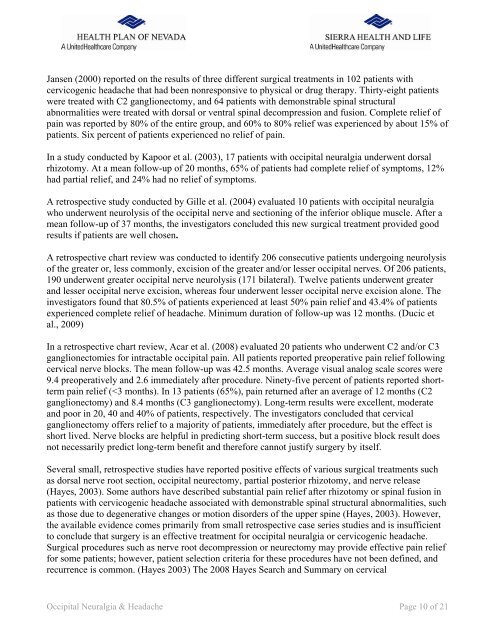OCCIPITAL NEURALGIA AND HEADACHE - Health Plan of Nevada
OCCIPITAL NEURALGIA AND HEADACHE - Health Plan of Nevada
OCCIPITAL NEURALGIA AND HEADACHE - Health Plan of Nevada
You also want an ePaper? Increase the reach of your titles
YUMPU automatically turns print PDFs into web optimized ePapers that Google loves.
Jansen (2000) reported on the results <strong>of</strong> three different surgical treatments in 102 patients with<br />
cervicogenic headache that had been nonresponsive to physical or drug therapy. Thirty-eight patients<br />
were treated with C2 ganglionectomy, and 64 patients with demonstrable spinal structural<br />
abnormalities were treated with dorsal or ventral spinal decompression and fusion. Complete relief <strong>of</strong><br />
pain was reported by 80% <strong>of</strong> the entire group, and 60% to 80% relief was experienced by about 15% <strong>of</strong><br />
patients. Six percent <strong>of</strong> patients experienced no relief <strong>of</strong> pain.<br />
In a study conducted by Kapoor et al. (2003), 17 patients with occipital neuralgia underwent dorsal<br />
rhizotomy. At a mean follow-up <strong>of</strong> 20 months, 65% <strong>of</strong> patients had complete relief <strong>of</strong> symptoms, 12%<br />
had partial relief, and 24% had no relief <strong>of</strong> symptoms.<br />
A retrospective study conducted by Gille et al. (2004) evaluated 10 patients with occipital neuralgia<br />
who underwent neurolysis <strong>of</strong> the occipital nerve and sectioning <strong>of</strong> the inferior oblique muscle. After a<br />
mean follow-up <strong>of</strong> 37 months, the investigators concluded this new surgical treatment provided good<br />
results if patients are well chosen.<br />
A retrospective chart review was conducted to identify 206 consecutive patients undergoing neurolysis<br />
<strong>of</strong> the greater or, less commonly, excision <strong>of</strong> the greater and/or lesser occipital nerves. Of 206 patients,<br />
190 underwent greater occipital nerve neurolysis (171 bilateral). Twelve patients underwent greater<br />
and lesser occipital nerve excision, whereas four underwent lesser occipital nerve excision alone. The<br />
investigators found that 80.5% <strong>of</strong> patients experienced at least 50% pain relief and 43.4% <strong>of</strong> patients<br />
experienced complete relief <strong>of</strong> headache. Minimum duration <strong>of</strong> follow-up was 12 months. (Ducic et<br />
al., 2009)<br />
In a retrospective chart review, Acar et al. (2008) evaluated 20 patients who underwent C2 and/or C3<br />
ganglionectomies for intractable occipital pain. All patients reported preoperative pain relief following<br />
cervical nerve blocks. The mean follow-up was 42.5 months. Average visual analog scale scores were<br />
9.4 preoperatively and 2.6 immediately after procedure. Ninety-five percent <strong>of</strong> patients reported shortterm<br />
pain relief (

















